Placing orders
To place an order you must first search for the vendor or bookseller and create a basket.
Warning
If you are planning on using EDIFACT to submit your order you will need to first set up your library’s EDI accounts and EANs.
Creating a basket
Note
Staff members must have the order_manage permission (or the superlibrarian permission) in order to create baskets and add orders.
Note
If you’re using EDI for ordering you will want to download your order record from your vendor before starting the process in Koha.
To create a basket you must first search for the vendor you’re ordering from. From the vendor search results, click the ‘New’ button and choose ‘Basket’.

Alternatively, you can click on the vendor’s name to access the vendor page and click ‘New’ and choose ‘Basket’ from there.
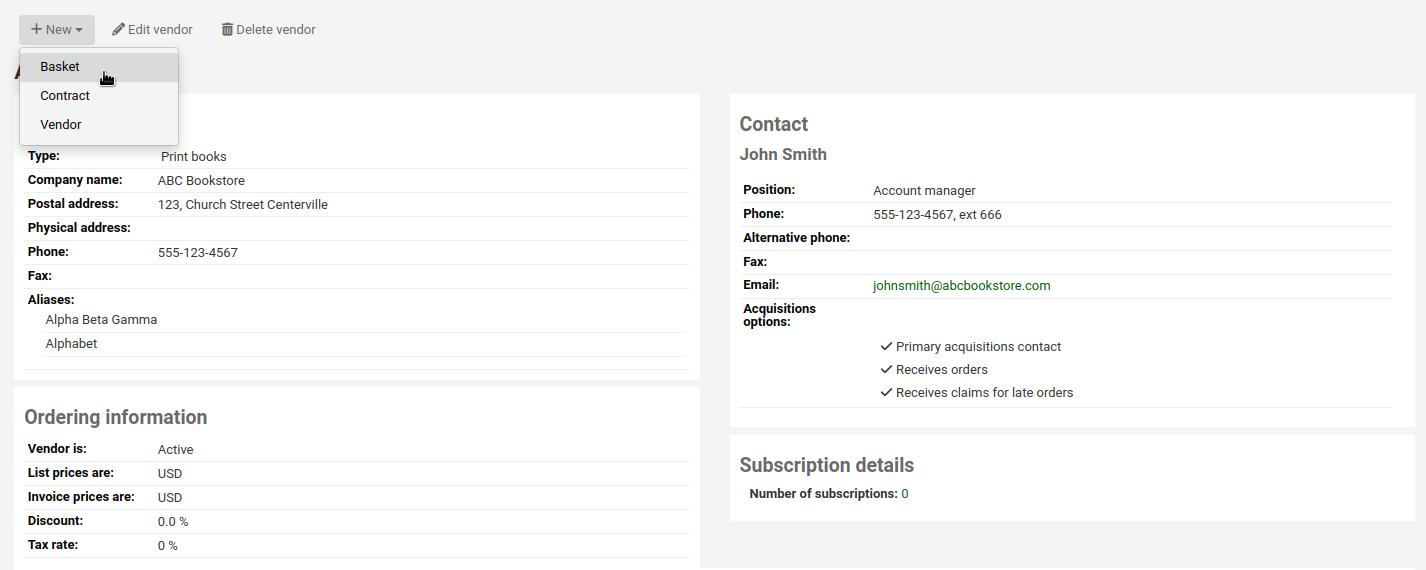
After clicking ‘New’ and ‘Basket’ you will be asked to enter some information about the order basket:
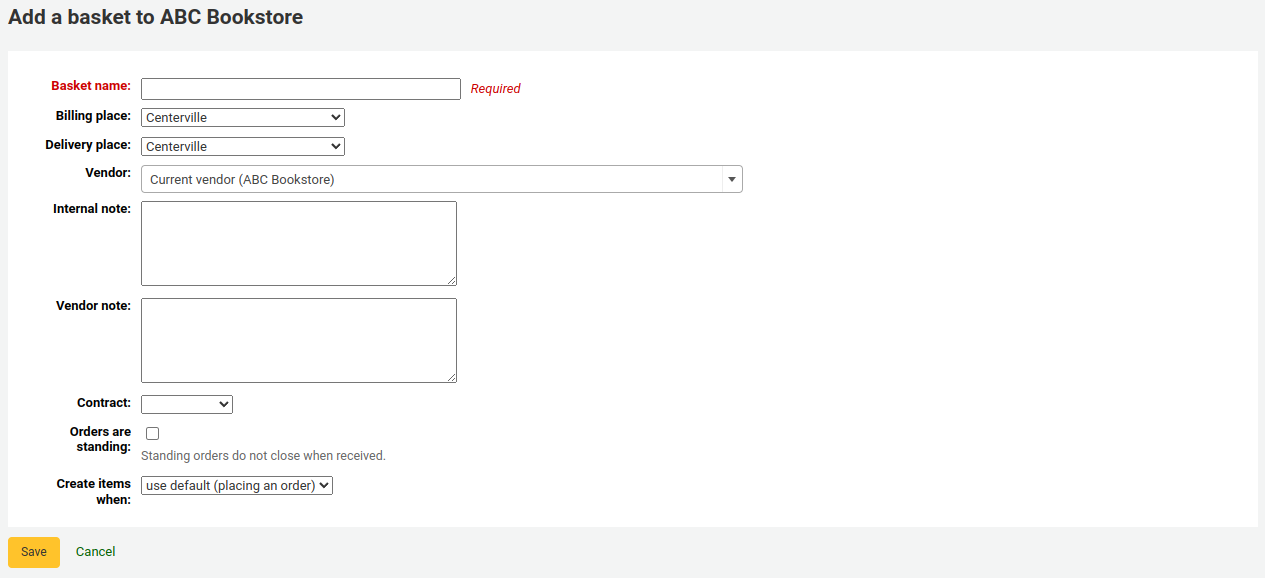
Give the basket a name that will help you identify it later
Enter in the billing place and delivery place (this will default the library you’re logged in at)
If you would like to change the vendor you’re ordering from you can use the Vendor pull down menu
The notes fields are optional and can contain any type of information
If you have added contracts to the vendor you’re ordering from, you will have an option to choose which contract you’re ordering these items under.
If you’re ordering standing items (items which arrive regularly), check the ‘Orders are standing’ box for this basket.
Note that one basket cannot contain both firm and standing orders.
You can choose to create items either upon placing the order, upon receiving the order, or upon cataloging the item. If you choose an option other than the default, it will apply only to this basket. The default is set by the AcqCreateItem system preference.
If you have additional fields for order baskets, they will appear here.
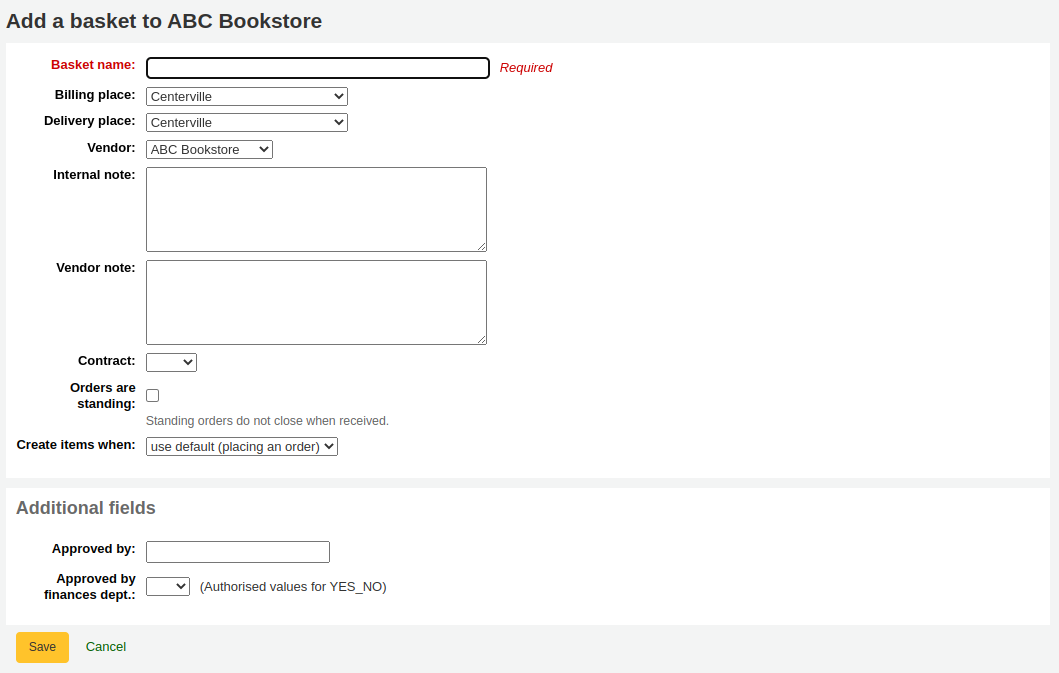
When finished, click ‘Save’.

Adding materials to the basket
Note
Staff members must have the order_manage permission (or the superlibrarian permission) in order to add orders to baskets.
Once your basket is created, click on ‘Add to basket’ from the basket page.

To add to an existing basket click ‘Add to basket’ to the right of an existing basket.

Several options for adding items to the order will be presented.
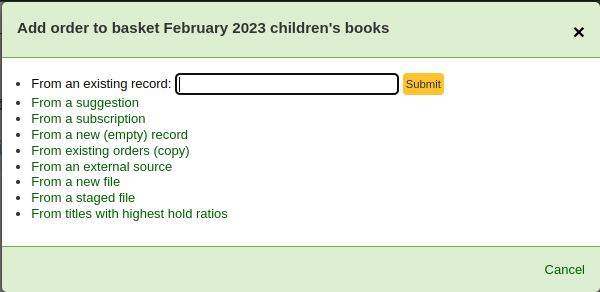
Order from an existing record
If you are ordering another copy of an existing item, you can simply search for the record in your system.
From the results, you can click ‘Add order’ to be brought to the order form.

From the record’s detailed view, you can click on the ‘Add order’ button.

You will be brought to the order form
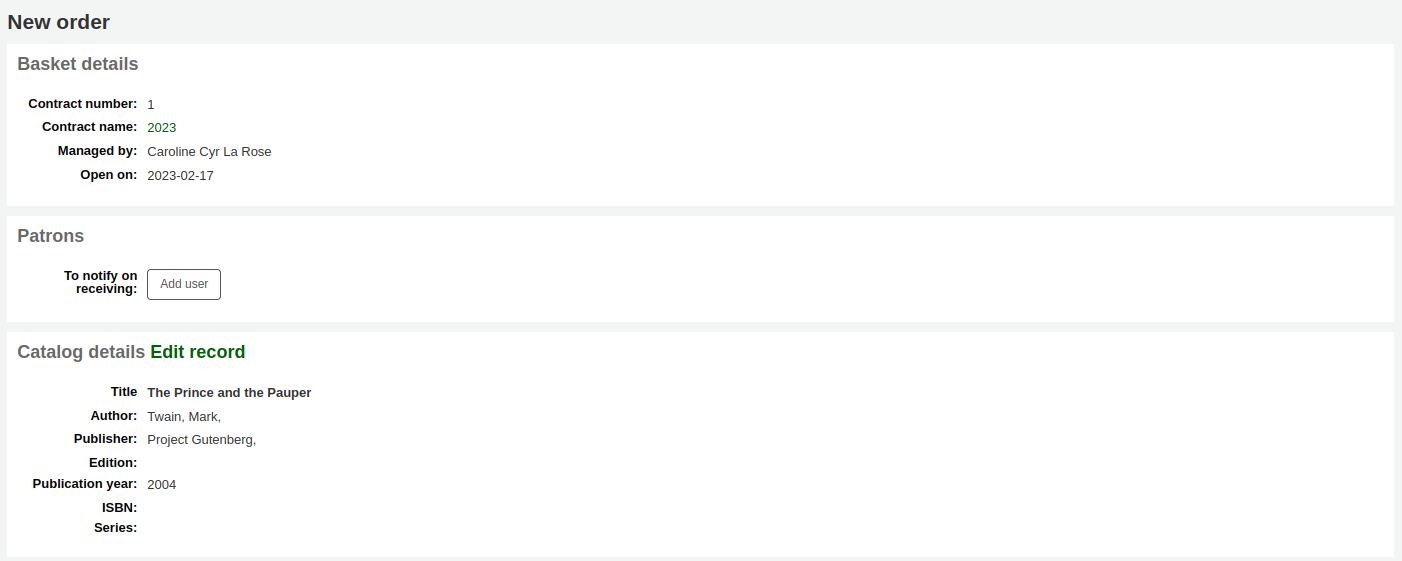
All of the details associated with the item will already be listed under ‘Catalog details.’
Fill out the rest of the order form, including patron notifications, items, and accounting details.
Order from a purchase suggestion
If you allow patrons to make purchase suggestions (learn more in the managing purchase suggestions section of this manual), you can place orders from those suggestions. In order to keep track of suggestions that have been ordered and received you must place the order using this link.
Warning
Suggestions must be accepted before you can order them.

From the results, click ‘Order’ next to the item you want to order and you will be presented with the order form including a link to the suggestion
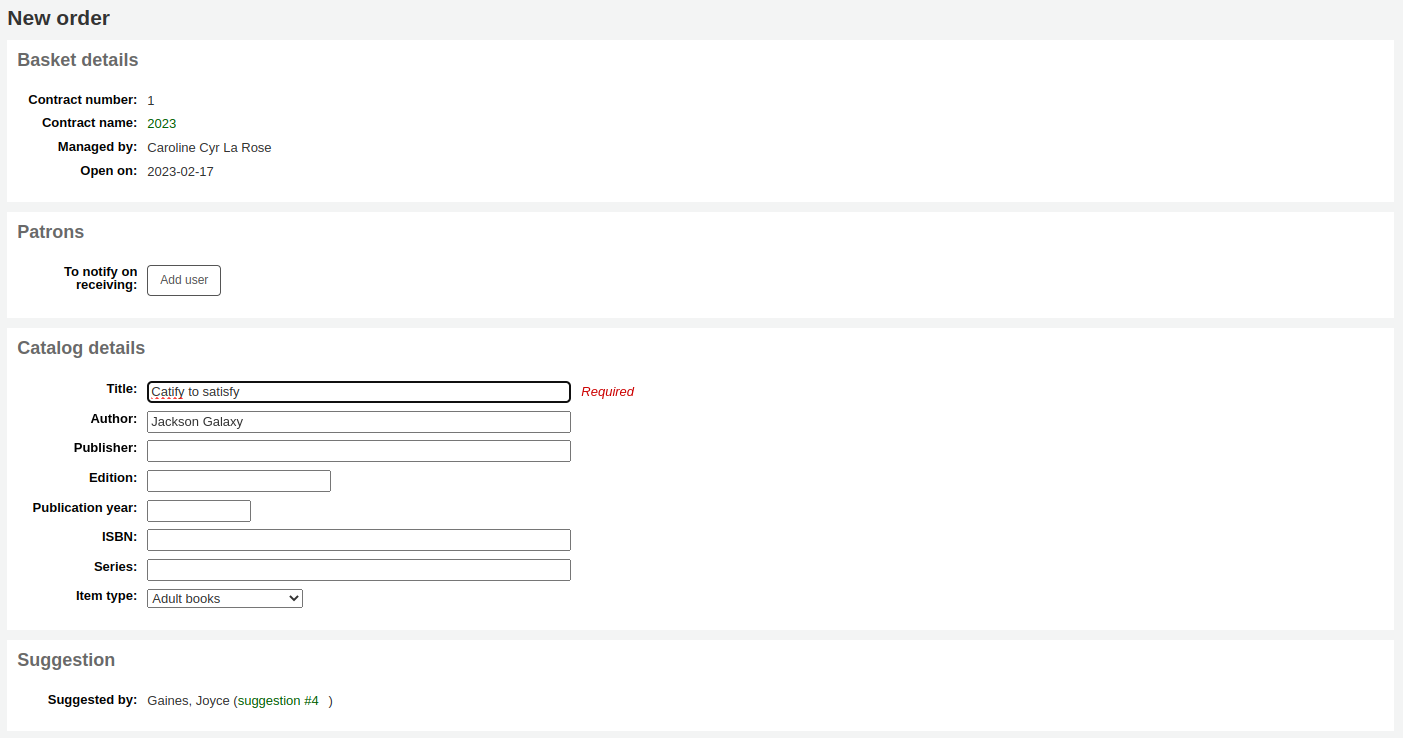
From this form you can make changes to the catalog details if necessary.
When the item appears in your basket it will include a link to the suggestion.

Orders added to the basket in this way will notify the patron via email that their suggestion has been ordered (with the ‘ORDERED’ notice in Tools > Notices and slips) and will update the patron’s ‘your purchase suggestions’ page in the OPAC.
Order from a serial subscription
If you are using the Serials module you can link your subscription order information to acquisitions by choosing to order ‘From a subscription’.
After clicking the order link you will be brought to a search page that will help you find your subscription

Your results will appear to the right of the form and each subscription will have an ‘Order’ link to the right

Clicking ‘Order’ will bring the subscription info in to the order form without an ‘Add item’ section since you are just ordering a subscription and an item is not needed
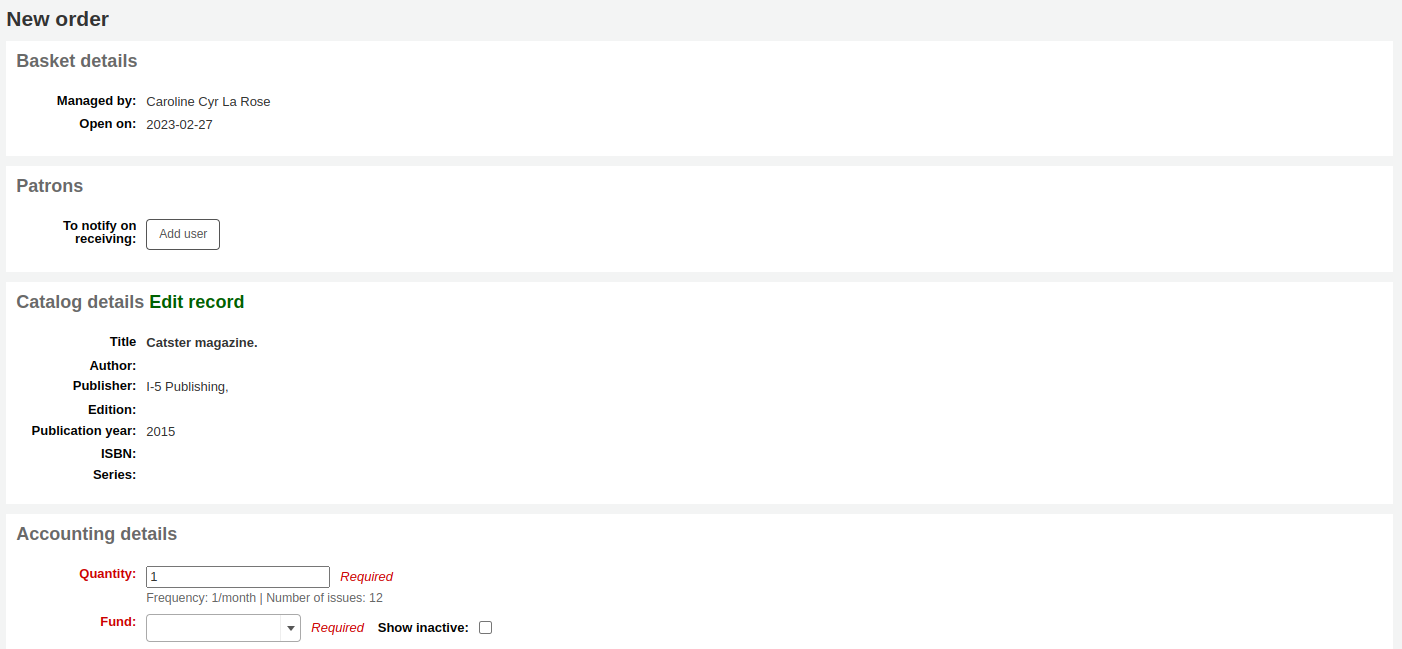
Order from a new (empty) record
To order from a record that can’t be found anywhere else, choose the ‘From a new (empty) record’ option.
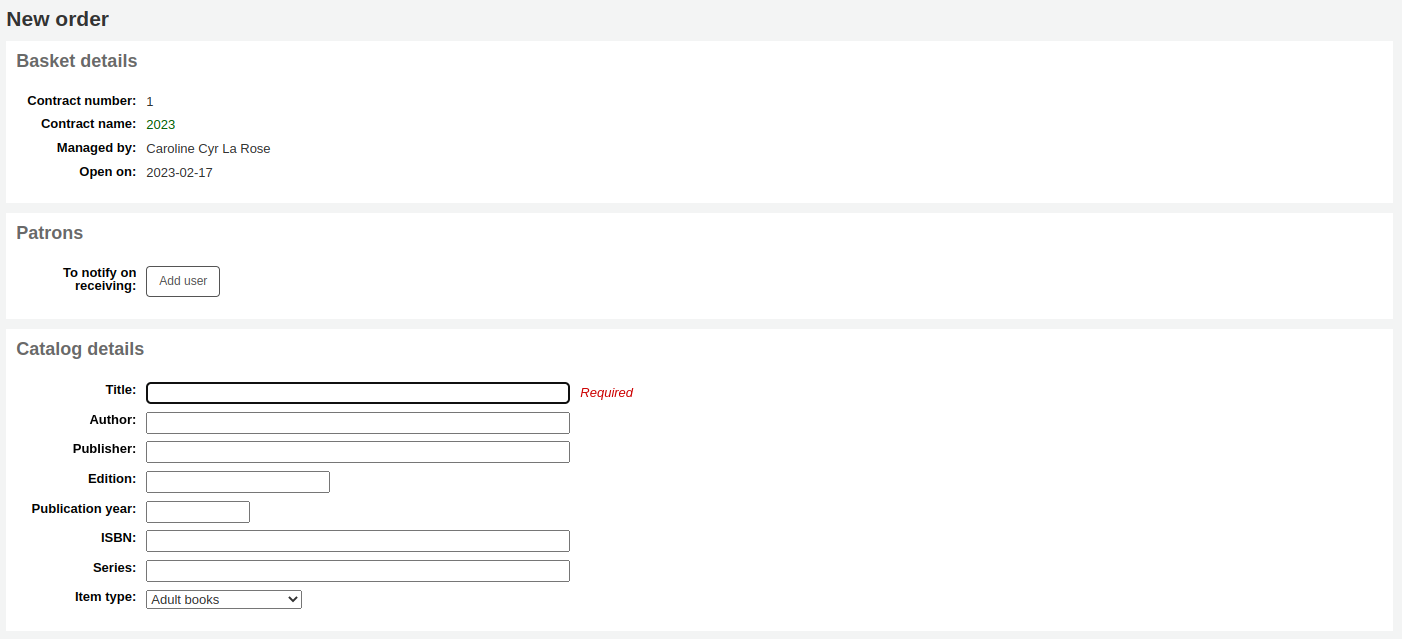
You will be presented with an empty form to fill in all of the necessary details about the item you are ordering.
Note
If the default form does not have the necessary bibliographic fields to place an order, enable the UseACQFrameworkForBiblioRecords preference which will allow the ACQ MARC framework to customize the display of fields when ordering.
Duplicate orders (order from existing orders)
You can duplicate an existing order line by choosing the ‘From existing orders (copy)’ option.
You will be presented with a search form to search your existing orders.
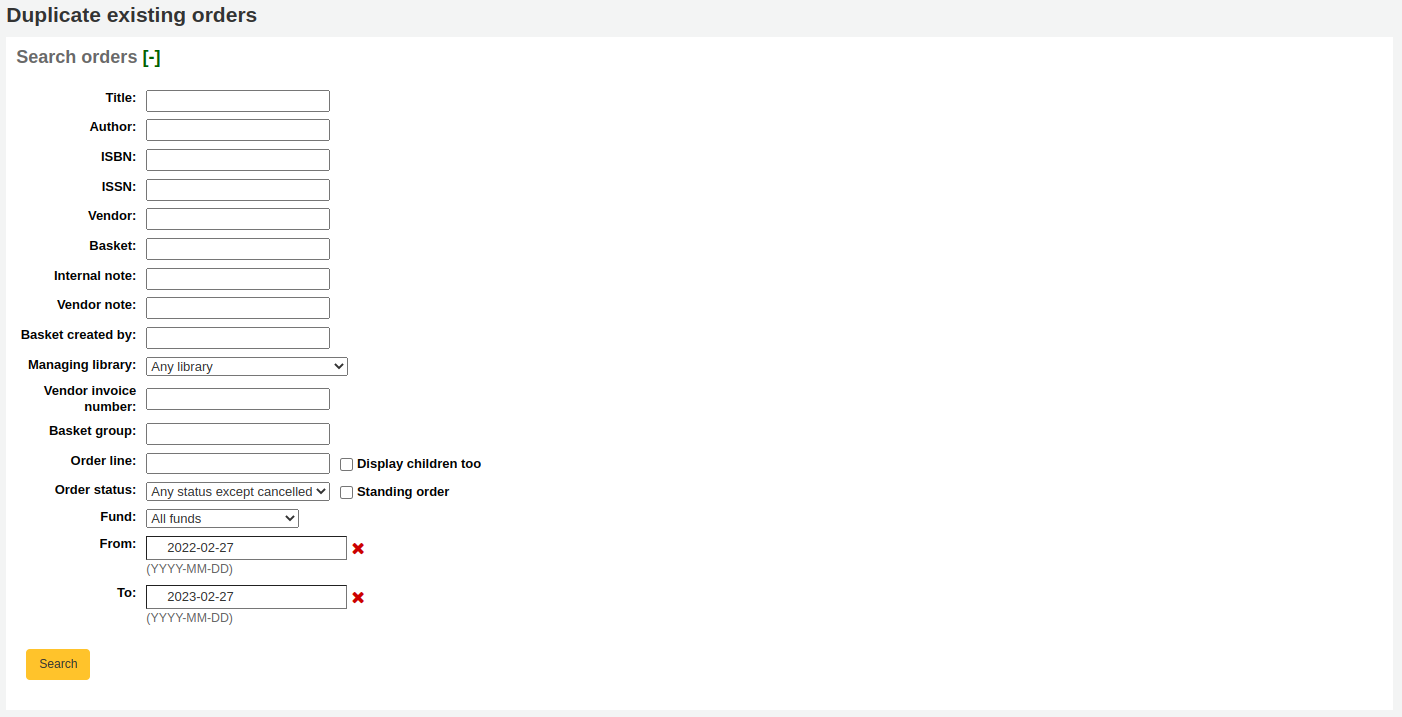
Check the boxes next to the order(s) you want to duplicate.
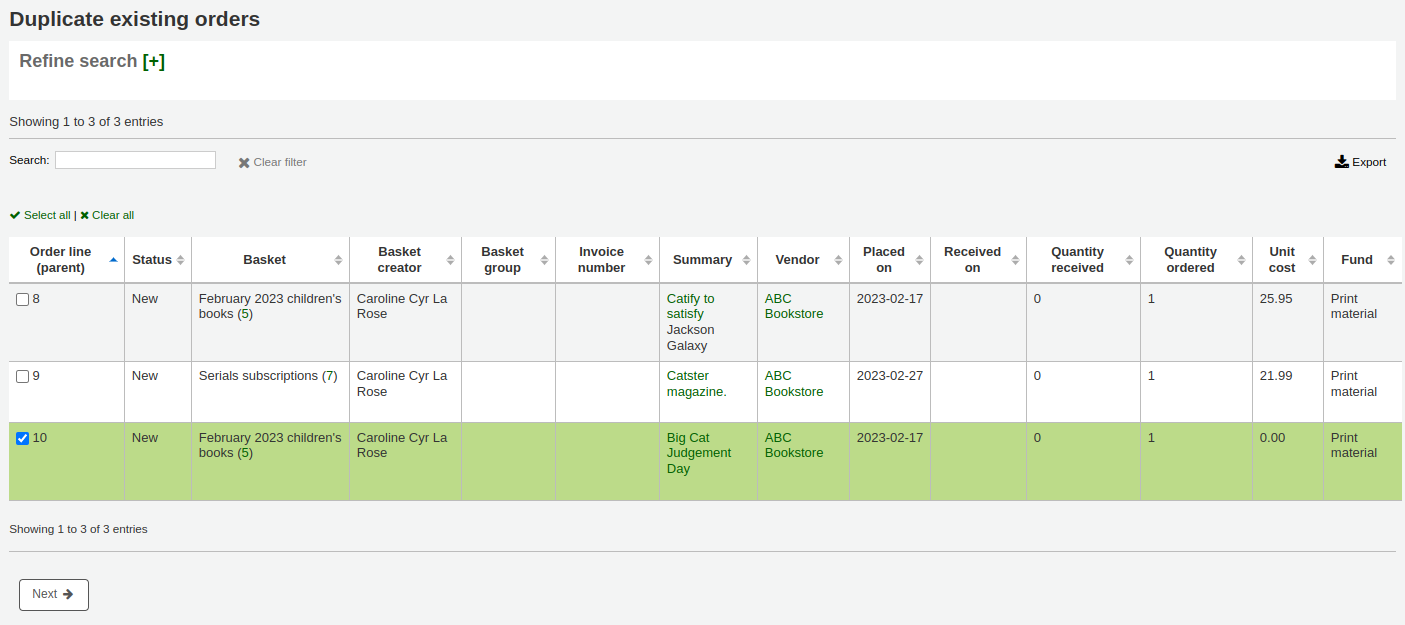
Click ‘Next’
Check the boxes next to the values to copy from the original order or choose new values.

Click ‘Duplicate orders’

Click ‘Return to the basket’
Order from an external source
You can search other library catalogs for the record of an item to purchase using the ‘From an external source’ option. This will allow you to order from a MARC record found via a Z39.50 search.

From the results, click anywhere in the row of the title you want to add to your basket and choose the ‘Order’ option.

If the item you’re ordering from an external source looks like it might be a duplicate, Koha will warn you and give you options on how to proceed.

Use existing record: order another copy on the existing bibliographic record
Cancel and return to order: cancel the order
Create new record: create a new bibliographic record, while keeping the existing one also
Order from a new file
If your vendor sent you a record file (a .mrc file for example), you can add orders using the records in that file. Choose the ‘From a new file’ option.
Note
Staff members must have the stage_marc_import permission (or the superlibrarian permission) in addition to the order_manage permission in order to be able order from a new file.
You will be taken to the Stage MARC records for import tool. Stage your file as described in that section.
Once the files are staged, you can click on the ‘Add staged files to basket’ button.

Next to each title is a checkbox, check the items you would like to order, or choose ‘Select all’ at the top. Depending on your settings in the MarcFieldsToOrder system preference, Koha will populate the next screen with with the relevant quantity, price, fund, statistic 1, and statistic 2 found within the staged file.
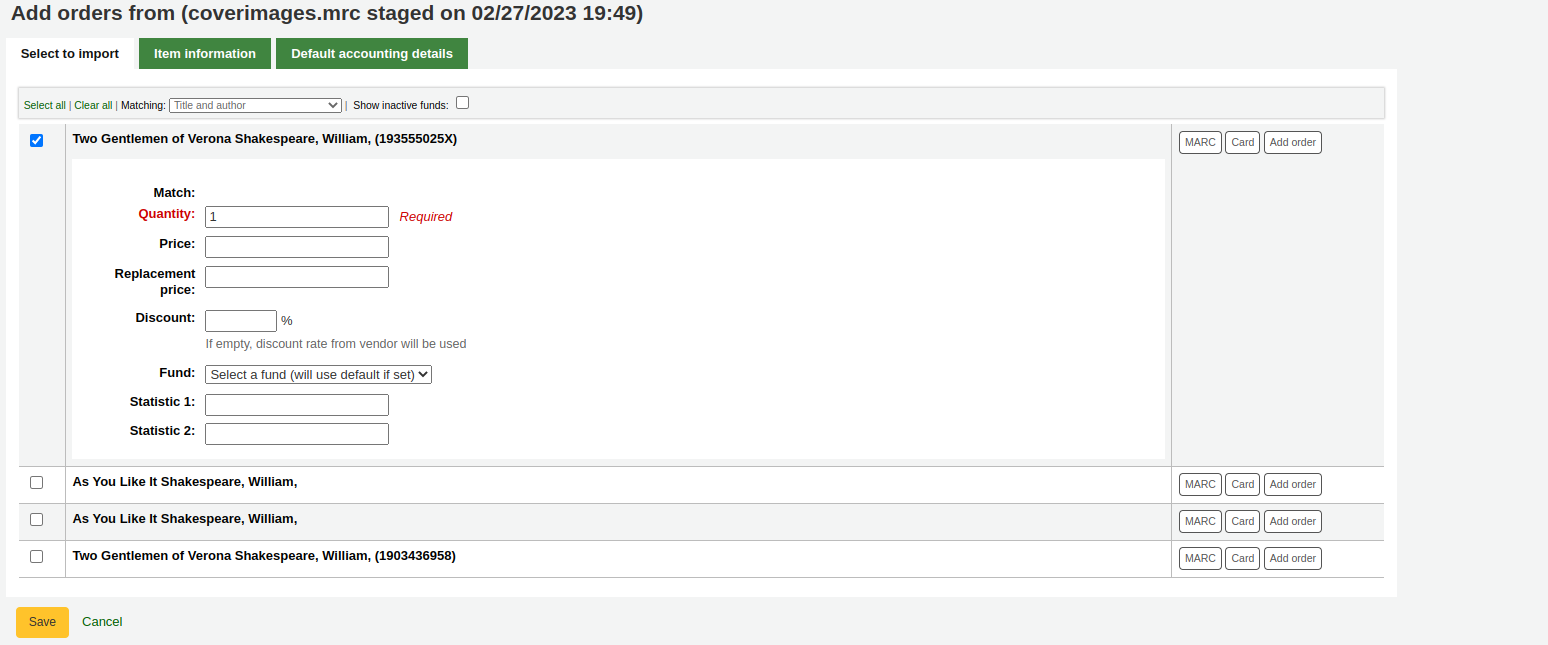
In the ‘Item information’ tab you can enter information that will be added to every ordered item such as item type, collection code and not for loan status.
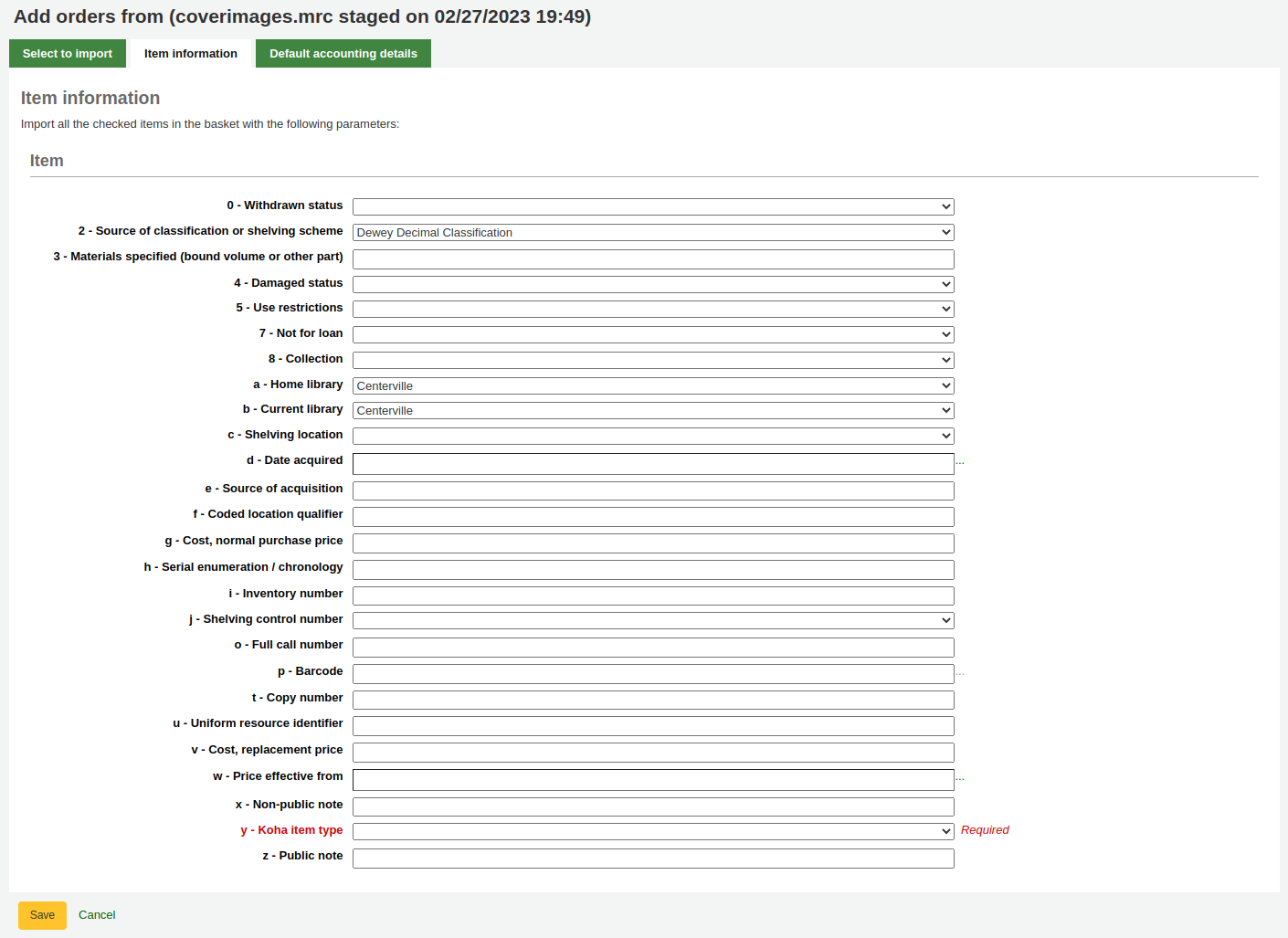
If no information is imported in the fund information from the MARC with the MarcFieldsToOrder system preference, the ‘Default accounting details’ tab can be used to apply values related to the accounting.
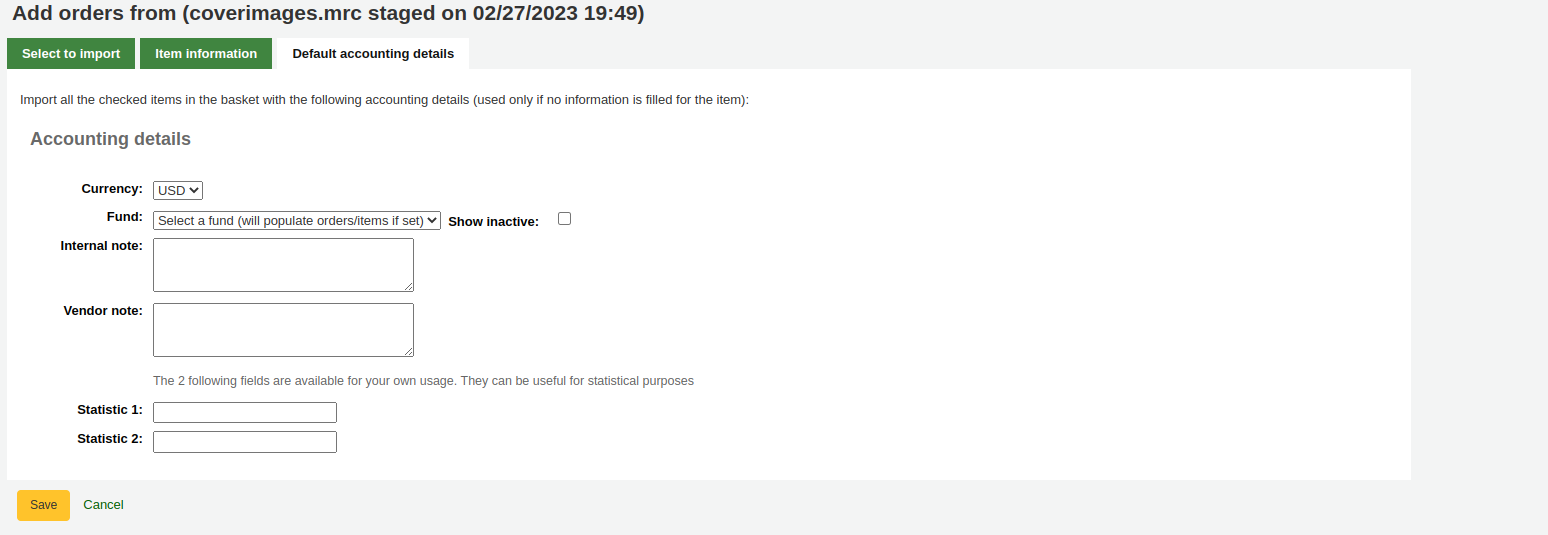
Click ‘Save’ to add to the basket
Order from a staged file
This option is the same as the previous one, but in this case, your file has already been staged. Whether you choose to ‘order from a new file’ or ‘order from a staged file’ will depend on your acquisitions workflow or your permissions.
Once you click on ‘From a staged file’, you will get a list of all the staged files in your system.

From the list of files you are presented with, click on the ‘Add orders’ button to add the records in the staged file to your order.
Next to each title is a checkbox, check the items you would like to order, or choose ‘Select all’ at the top. Depending on your settings in the MarcFieldsToOrder system preference, Koha will populate the next screen with with the relevant quantity, price, fund, statistic 1, and statistic 2 found within the staged file.

In the ‘Item information’ tab you can enter information that will be added to every ordered item such as item type, collection code and not for loan status.

If no information is imported in the fund information from the MARC with the MarcFieldsToOrder system preference, the ‘Default accounting details’ tab can be used to apply values related to the accounting.

Click ‘Save’ to add to the basket
Order from titles with highest hold ratios
The final option for ordering is to order from a list of titles with the highest hold ratios.
Note
Staff members must have the circulate_remaining_permissions permission (or the superlibrarian permission) in addition to the order_manage permission in order to be able order from titles with high hold ratios.
This option will take you to the holds ratio report where you can find items with a high hold ratio and order additional copies. Next to each title will be a button with the number of items to order, click that and it will add the item to your basket.

Setting up patron notifications
With any of the above ordering options you’re presented with an option to notify patrons of the new item when it’s received. The contents of that notification can be edited in the Notices and slips tool and will have the code of ACQ_NOTIF_ON_RECEIV. In the ‘Patrons’ section you will see an option to ‘Add user’. Click that button to add patrons who will be notified of the new issue.
Patron notification search
In the window that pops up search for the patrons you’d like to notify and click ‘Add’
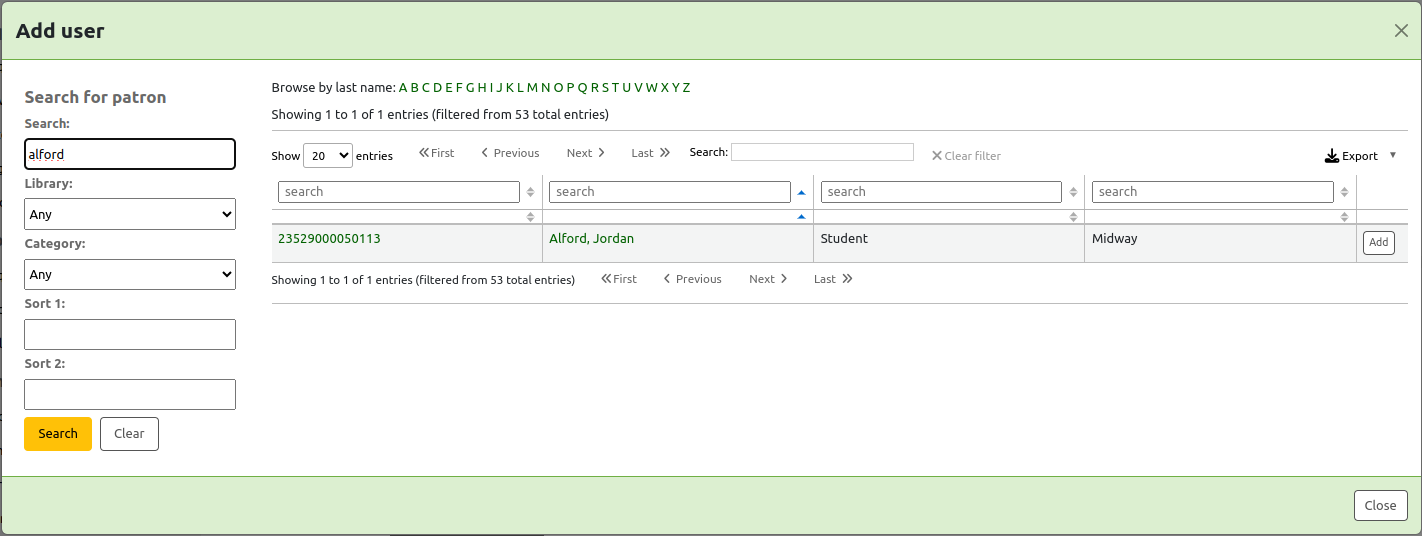
Once you’re done you can close the window and you’ll see the list of patrons under the ‘Patrons’ section

Adding items to orders
After bringing in the record information (for all order methods except for the staged files), if your AcqCreateItem system preference is set to add an item when ordering you will enter the item information next. You need to fill out at least one item record and then click the ‘Add item’ button at the bottom left of the item form.
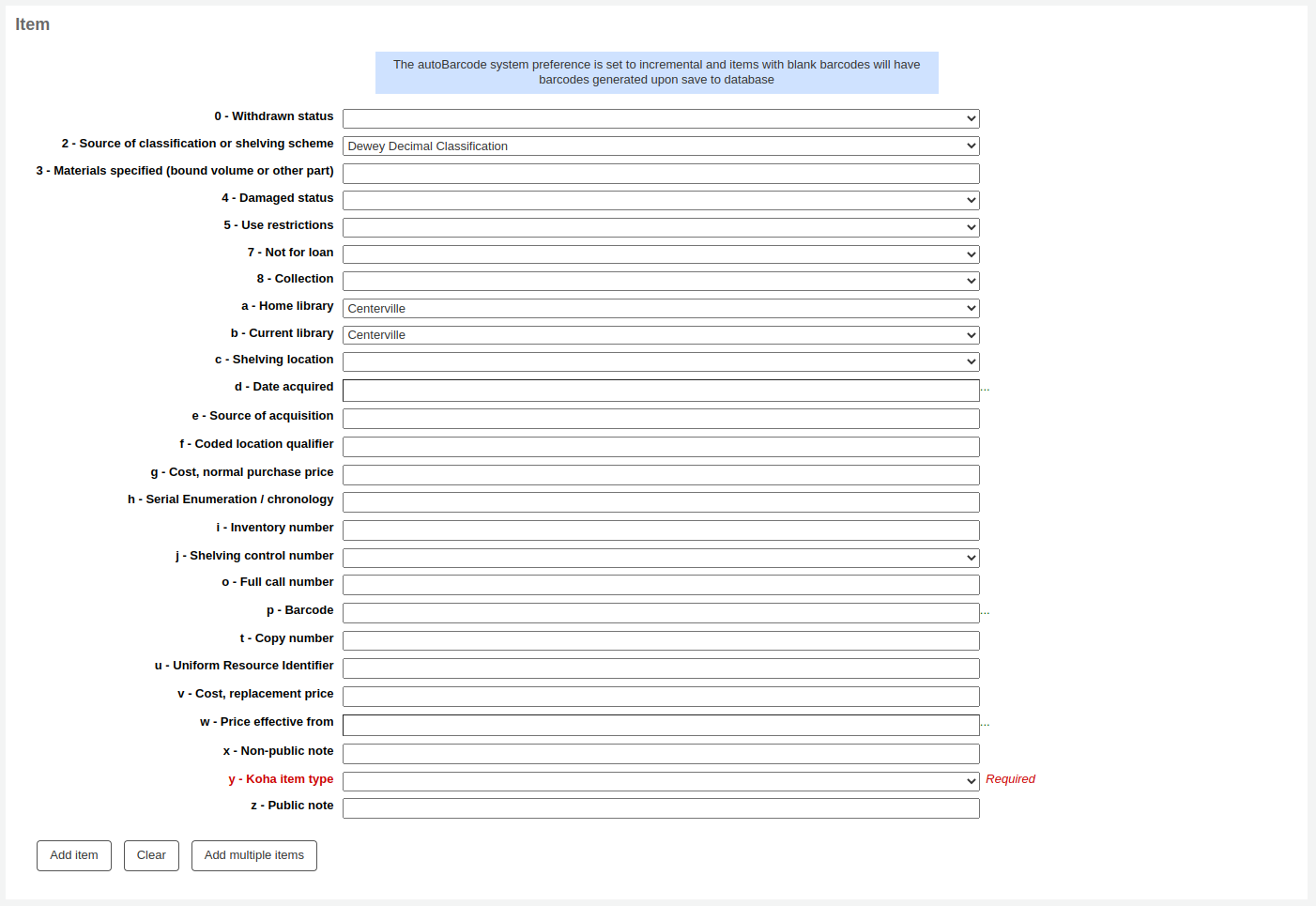
After clicking the ‘Add item’ button below the item record the item will appear above the form and then you can enter your next item the same way (if ordering more than one item).

If you are ordering several items, you can click on the ‘Add multiple items’ instead of adding them one by one. This will ask you how many items you want to add. Simply enter that number in the box and click on ‘Add’.

Adding accounting details to orders
Once you have entered the info about the item, you need to enter the Accounting information.
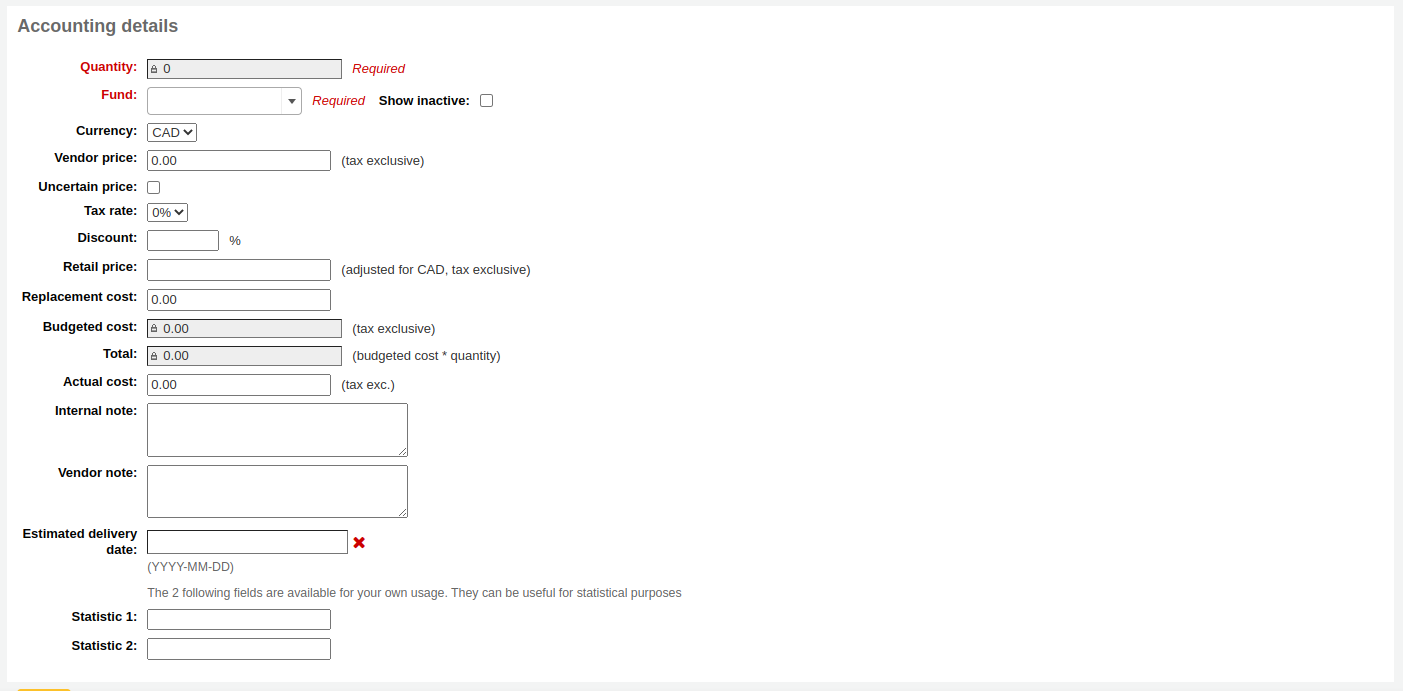
Quantity: enter the quantity of copies you want to order.
Warning
If the item is created upon ordering, you will not be able to edit the quantity manually, you must add items to the order by clicking ‘Add item’ below the item form to add as many items as you’re ordering.
Fund: choose the fund that will be used to buy this title.
The list of funds is populated by the funds you have created in the Acquisitions administration area.
If you have a lot of funds, you can start to type the fund name in the field and the list will be filtered for you.
By default, only funds for active budgets will be available in the drop-down menu. If you need to also see your inactive funds, check the ‘Show inactive’ box.
Currency: choose the currency of the price.
The currency pull down will have the currencies you set up in the Acquisitions administration area.
Vendor price: enter the price before any taxes or discounts are applied.
Uncertain price: if the price is uncertain, check the uncertain price box. You will be able to go back later to enter the right price.
Note
A basket with at least one uncertain price cannot be closed.
See the section Dealing with uncertain prices below to learn how to manage uncertain prices.
Tax rate: if you are charged sales tax, choose the rate.
This field is populated by the TaxRates system preference.
Discount: enter the percentage discount you’re receiving on this order. Once you enter this, hit tab and Koha will populate the rest of the cost fields below.
Retail price: enter the recommended retail price (RRP), the price set by the publisher or the manufacturer as a recommendation to booksellers.
Replacement cost: enter the cost to replace the item. This is the price charged to the user when an item is declared lost (if the WhenLostChargeReplacementFee system preference is set to ‘Charge’).
Budgeted cost is the amount that will be removed from the ‘spent’ budget. Whether this number includes or excludes taxes will depend on the ‘List price’ setting for your vendor.
Total is the budgeted cost multiplied by the quantity of items ordered.
Actual cost: this field is usually left empty until receiving, when you can confirm the actual cost against the vendor’s packing slip or invoice.
Internal note: this will only appear in the acquisitions module and in the staff interface catalog, under the ‘Acquisitions details’ tab in the detailed record.
Vendor note: this will appear in the acquisitions module as well as on the order when exported as CSV.
Estimated delivery date: you can specify an estimated delivery date for this specific order. If no date is entered here, the estimated delivery date will be calculated according to the ‘Delivery time’ in the vendor information. This date is used when managing late orders
If you added statistical categories when creating the fund, those values will appear in the two statistics fields.
If you have additional fields for order lines, they will appear here.
Once you have filled in all of the fields click ‘Save’ to add the item to your basket. If your price goes over the amount available in the fund you will be presented with a confirmation.

The confirmation warning will allow you order past your fund amount if you so choose.
Once your order is entered you can search for it through acquisitions or view the information on the bibliographic record detail page in the staff interface, if the AcquisitionDetails system preference is set to ‘Display’, or view the information on the bibliographic record detail page in the OPAC, if the OPACAcquisitionDetails system preference is set to ‘Display’.

Note
You can customize the columns of this table in the ‘Table settings’ section of the Administration module (table id: acquisitiondetails-table).
Editing the basket
Note
Staff members must have the order_manage permission (or the superlibrarian permission) in order to edit existing baskets.
After an item is added to the basket you will be presented with a basket summary.
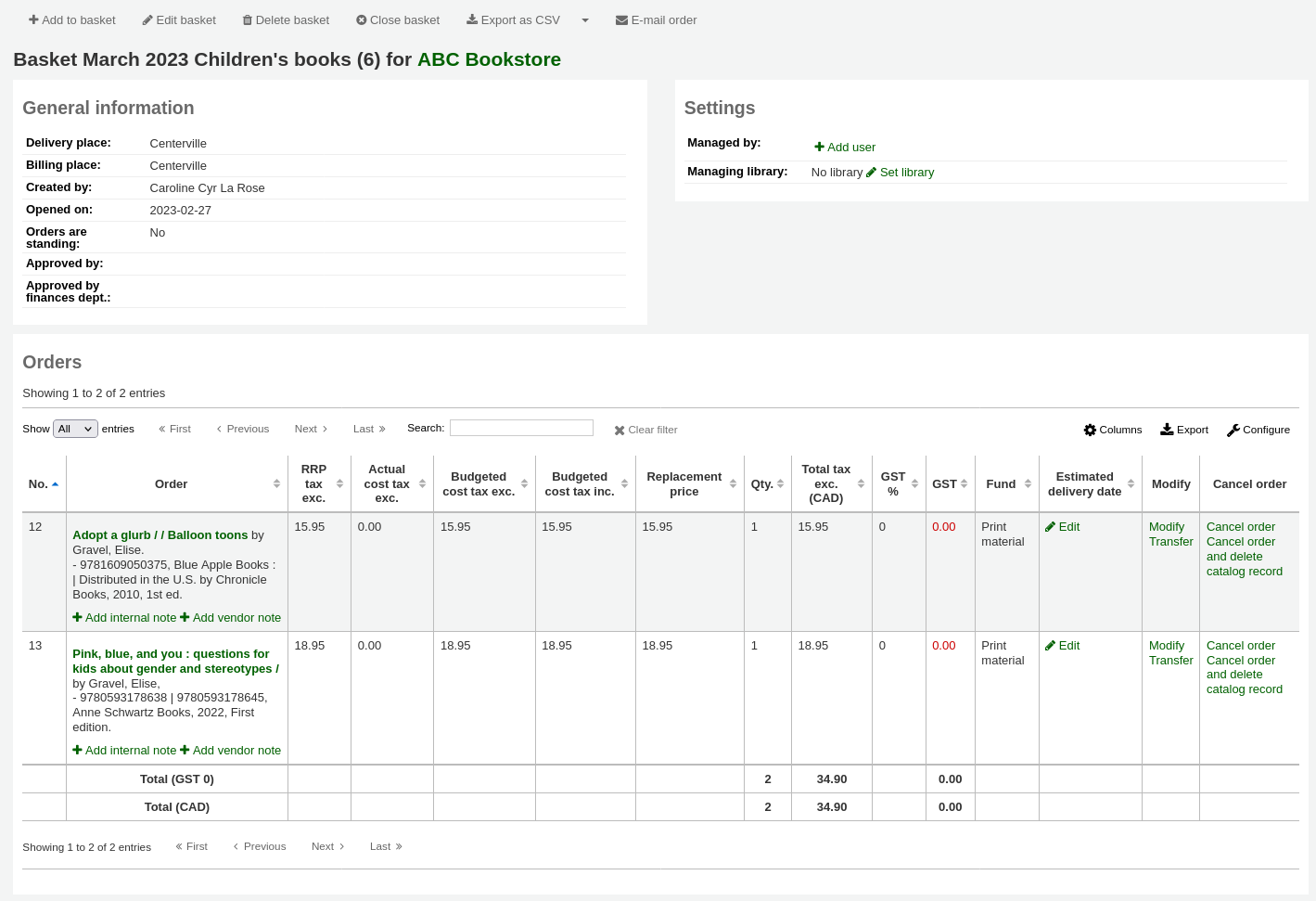
Note
You can customize the columns of this table in the ‘Table settings’ section of the Administration module (table id: orders).
From the basket, you can edit or remove the items that you have added.
Choosing to ‘Modify’ the order will take you back into the order form in case you need to modify the accounting details or the items.
Choosing to ‘Transfer’ the order will allow you to move this order from this vendor’s basket into a different vendor’s basket.
Note
The new vendor must have at least one open basket for you to be able to transfer the order.
Choosing to ‘Place Hold’ will allow you to place a hold for a patron on this order.
Choosing to ‘Cancel the order’ will delete the order line but leave the record in the catalog.
Choosing to ‘Cancel order and delete catalog record’ removes both the order line and the record in the catalog.
The catalog record cannot always be deleted. You might see notes explaining why.
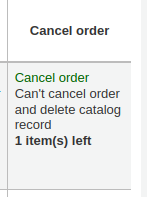
Note
If the order was created from a suggestion, the status of the suggestion will be reset from ‘Ordered’ back to ‘Accepted’ if the order is cancelled.
On the summary page, you also have the several option through the buttons at the top of the basket header.

Add to basket: add orders to the basket
Edit basket: edit the basket information, such as the name or the billing place.
Delete basket: if the basket is empty, you will get a simple confirmation message before deleting the basket. If the basket contains orders, you will get a confirmation message with several options.
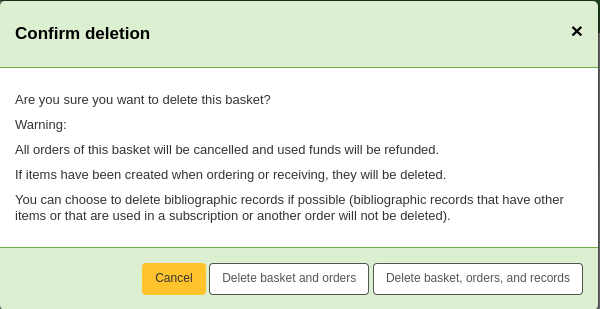
Delete basket and orders: this will delete the basket, cancel the orders, refund the used funds, and delete the items (ordered or received).
Delete basket, orders, and records: this will delete all of the above plus the bibliographic records associated with the orders (except the ones which can’t be deleted because they have remaining items, orders or subscriptions attached).
Close basket: closing the basket will enable you to add it to a basket group (this is optional) and receive its items.
Export as CSV: this will create a CSV file with all your orders from this basket. You can add several CSV profiles options by going to the CSV profiles tool.
Create EDIFACT order: if you’re using EDI for your order you can click the ‘Create EDIFACT order’ button when you’re done to send the file to the vendor and close the basket.
E-mail order: this will send the order information to your contact for this vendor. Make sure your contact has a email address in the vendor profile.
Note
The email sent is based on the ACQORDER notice template. It can be customized in the Notices and slips tool.
Ordering (closing the basket)
Note
Staff members must have the order_manage permission (or the superlibrarian permission) in order to close existing baskets.
Once you’re sure your basket is complete, you can click ‘Close this basket’ button to indicate that this basket is complete and has been sent to the vendor.

Warning
You must close the basket to be able to receive items when they arrive. Only items in closed baskets will show as ready to receive.
If you have your BasketConfirmations system preference set to show a confirmation, you will be asked if you are sure about closing the basket.

When closing the basket you can choose to add the basket to a group for easy printing and retrieval. If you check the box to ‘Attach this basket to a new basket group with the same name’ you will be brought to the group list where you can export a PDF of the order.

Warning
A basket with at least one item marked as ‘uncertain price’ will not be allowed to be closed.
See the section Dealing with uncertain prices below to learn how to manage uncertain prices.
Dealing with uncertain prices
Warning
A basket with at least one item marked as ‘uncertain price’ will not be allowed to be closed.
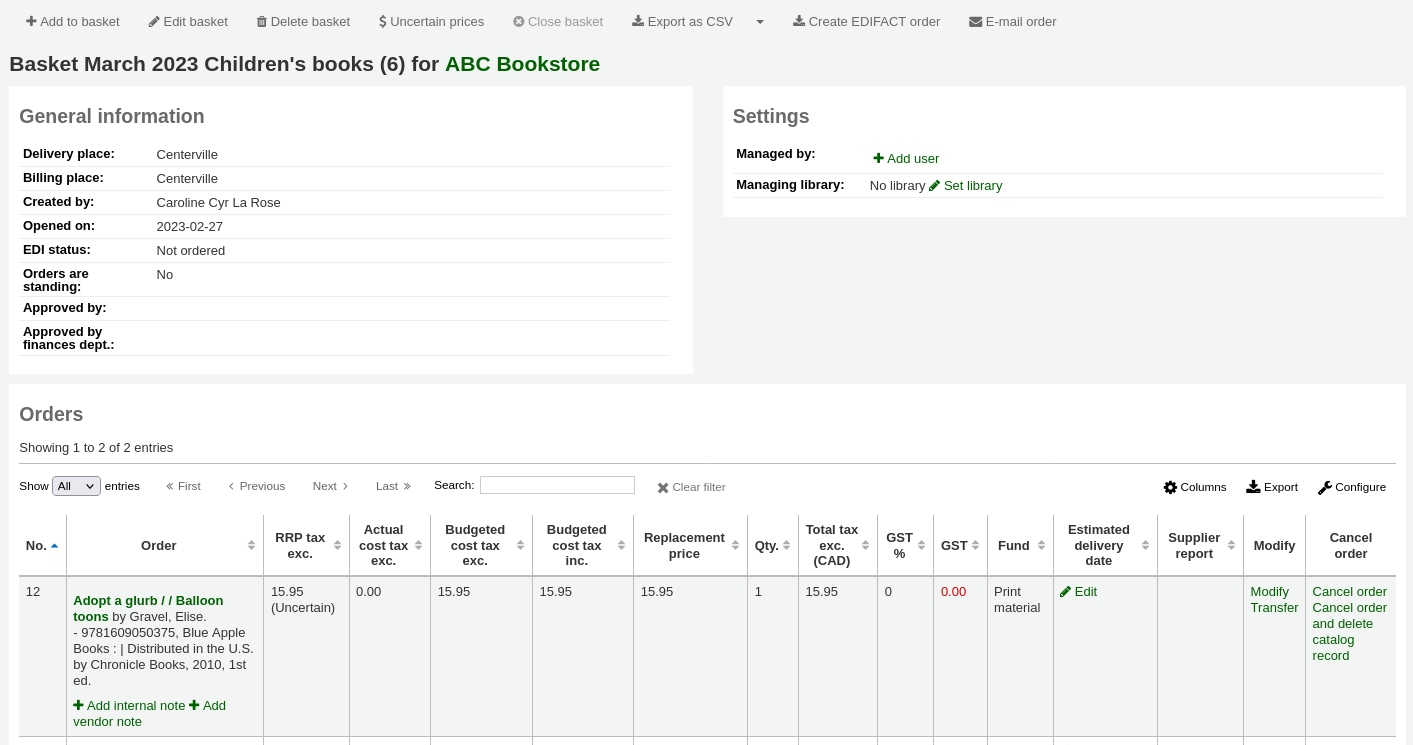
Clicking the ‘Uncertain prices’ button will call up a list of items with uncertain prices to quick editing. From that list, you can quickly edit the items by entering new prices and quantities.
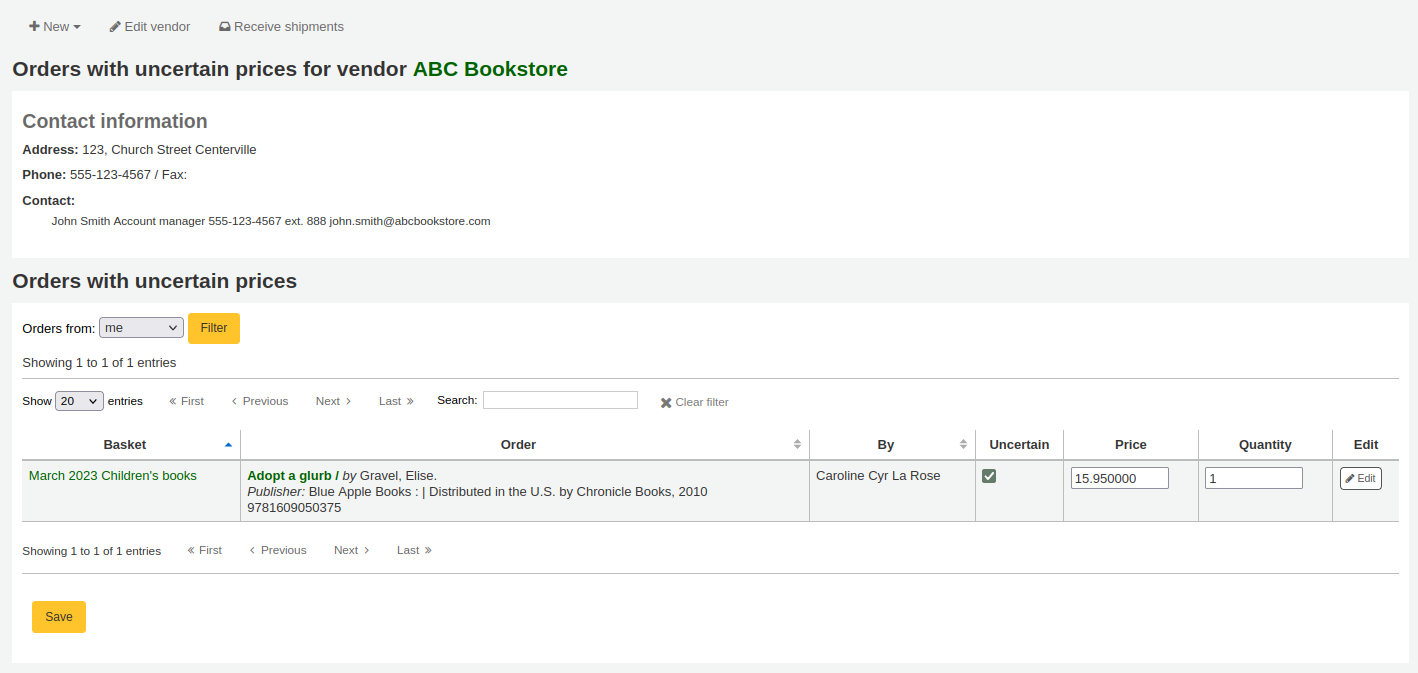
Note
The Uncertain prices page is independent of the basket. It is linked to the vendor so you will see all items on order with uncertain prices for that vendor.
Creating a basket group
A basket group is simply a group of baskets. In some libraries, several staff members create baskets, and, at the end of a period of time, someone groups them together to send to the vendor in bulk. Note that it is possible to have one basket in a basket group, or no basket groups at all if that’s the workflow used in your library.
Note
Staff members must have the group_manage permission (or the superlibrarian permission) in order to create, edit, close, and delete basket groups.
Note
You cannot re-open a basket that is attached to a basket group. The re-open basket button will be grayed out.
To create a basket group, go to the vendor detail page and click on the ‘Basket groups’ tab on the left side.
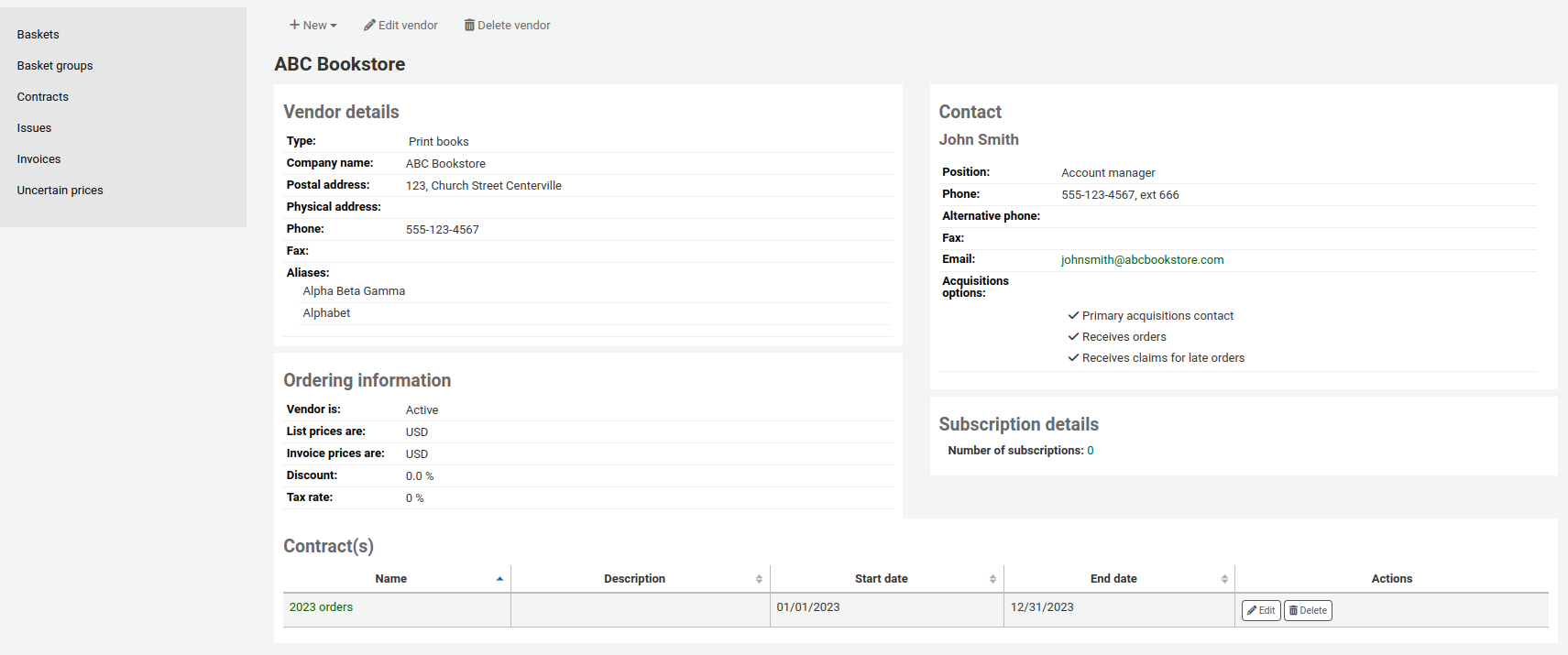

Click on the ‘New basket group’ button.
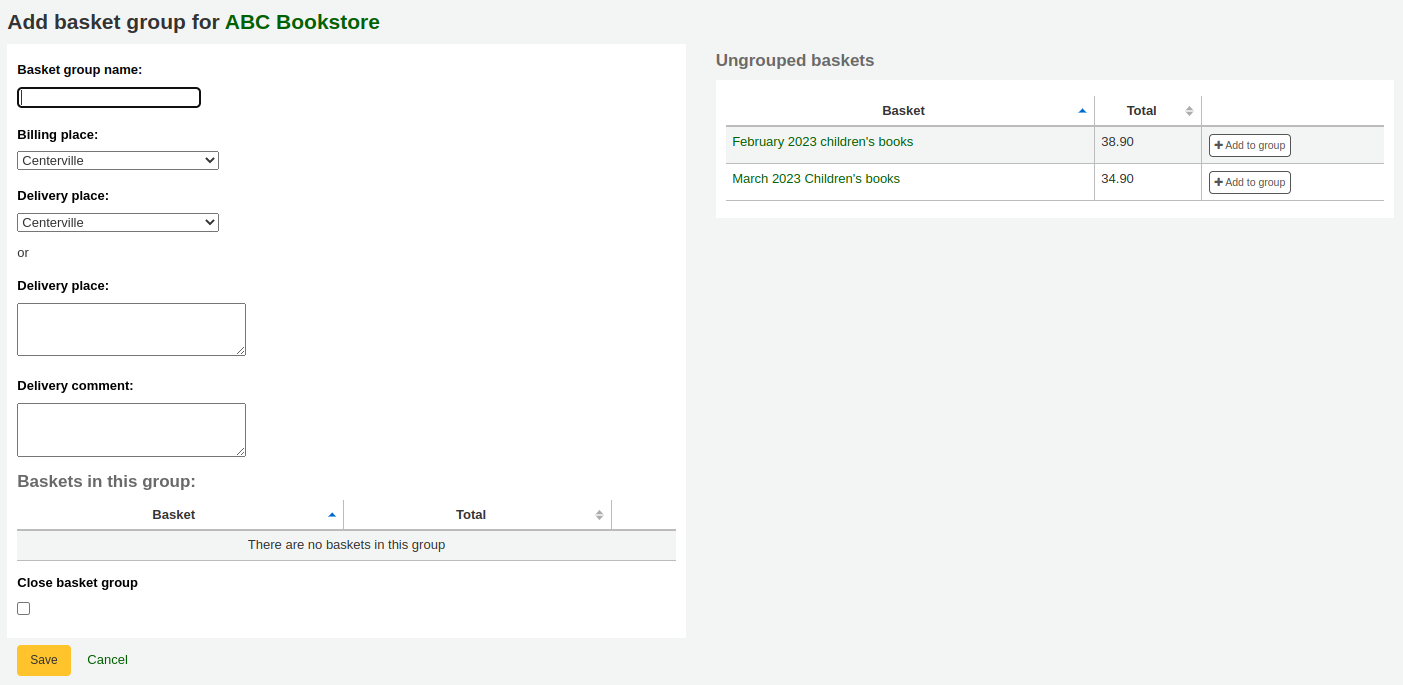
Basket group name: this is the name the basket group will go by in Koha
Billing place: this is the billing address that will appear on the basket group order
Delivery place: pick a library where these orders should be sent, this will appear on the basket group order under delivery address You can also enter a different address
Delivery comment: this comment will appear on the basket group order
Close basket group: if you know that once you’re done with this basket group, you will not be modifying it anymore, you can check this box and the group will be closed upon saving
Add baskets to the group by clicking the ‘Add to group’ button on the right.
Click on ‘Save’ to finish creating your basket.
From there, you can export your order as a PDF file to send to your vendor.
Note
The content of the PDF file is not editable, but it is possible to change its language and formatting with the OrderPdfFormat system preference.
If using the ‘English 1-Page’ option, it is possible to customize the text written above the order table with the 1PageOrderPDFText system preference.
